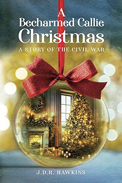
 |
In this novel of historical fiction, the author delivers the flavor and essence of high society life in the South during the Civil War era. The charmed and unfazed young belles get glimpses of the outside world, though they tend to quickly look away. They are a living portrait of joyful naïveté and innocence. The main character, Callie Copeland, plans parties and thinks about boys. She is a privileged and sheltered sixteen-year-old beauty, and she is well aware of it. Her cares about the war are usually remote, but sometimes bubble to the surface, "She suddenly realized how fragile life was. So many soldiers had died, and so many families had lost their loved ones. She was one of the lucky ones."
This book could serve as a companion to the novel Gone With the Wind with respect to its focus on the cares of young privileged ladies of the 1860s: "There would be no more worries until after the Yule, and she would make happy, even if it meant appearing insensitive." Perhaps the best elements within the narrative are the artful descriptions that take readers right into the life of the South's elite with their details of the antebellum homes, rooms, and decor. "A thick pink quilt covered her four-poster bed. A fire crackled in the white marble fireplace at the opposite end of the room." The message is subtle but obvious that war is unspeakably terrible, even amongst those who are living more remotely and are less aware of the ugliness of military conflict directly. As all good authors do, Hawkins shows rather than tells, never preaching. The book ends each chapter with a letter home from the war front. It brings the juxtaposing viewpoints to the forefront. In short, Hawkins’ novel is exquisitely done.